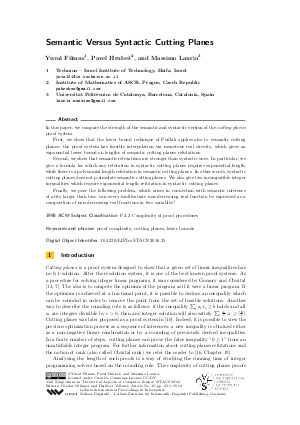Semantic Versus Syntactic Cutting Planes
Authors Yuval Filmus, Pavel Hrubeš, Massimo Lauria
-
Part of:
Volume:
33rd Symposium on Theoretical Aspects of Computer Science (STACS 2016)
Part of: Series: Leibniz International Proceedings in Informatics (LIPIcs)
Part of: Conference: Symposium on Theoretical Aspects of Computer Science (STACS) - License:
 Creative Commons Attribution 3.0 Unported license
Creative Commons Attribution 3.0 Unported license
- Publication Date: 2016-02-16
File

PDF
LIPIcs.STACS.2016.35.pdf
- Filesize: 0.63 MB
- 13 pages
Document Identifiers
Subject Classification
Keywords
- proof complexity
- cutting planes
- lower bounds
Metrics
- Access Statistics
-
Total Accesses (updated on a weekly basis)
0PDF Downloads0Metadata Views
Abstract
In this paper, we compare the strength of the semantic and syntactic version of the cutting planes proof system. First, we show that the lower bound technique of Pudlák applies also to semantic cutting planes: the proof system has feasible interpolation via monotone real circuits, which gives an exponential lower bound on lengths of semantic cutting planes refutations. Second, we show that semantic refutations are stronger than syntactic ones. In particular, we give a formula for which any refutation in syntactic cutting planes requires exponential length, while there is a polynomial length refutation in semantic cutting planes. In other words, syntactic cutting planes does not p-simulate semantic cutting planes. We also give two incompatible integer inequalities which require exponential length refutation in syntactic cutting planes. Finally, we pose the following problem, which arises in connection with semantic inference of arity larger than two: can every multivariate non-decreasing real function be expressed as a composition of non-decreasing real functions in two variables?
Cite As Get BibTex
Yuval Filmus, Pavel Hrubeš, and Massimo Lauria. Semantic Versus Syntactic Cutting Planes. In 33rd Symposium on Theoretical Aspects of Computer Science (STACS 2016). Leibniz International Proceedings in Informatics (LIPIcs), Volume 47, pp. 35:1-35:13, Schloss Dagstuhl – Leibniz-Zentrum für Informatik (2016)
https://doi.org/10.4230/LIPIcs.STACS.2016.35
BibTex
@InProceedings{filmus_et_al:LIPIcs.STACS.2016.35,
author = {Filmus, Yuval and Hrube\v{s}, Pavel and Lauria, Massimo},
title = {{Semantic Versus Syntactic Cutting Planes}},
booktitle = {33rd Symposium on Theoretical Aspects of Computer Science (STACS 2016)},
pages = {35:1--35:13},
series = {Leibniz International Proceedings in Informatics (LIPIcs)},
ISBN = {978-3-95977-001-9},
ISSN = {1868-8969},
year = {2016},
volume = {47},
editor = {Ollinger, Nicolas and Vollmer, Heribert},
publisher = {Schloss Dagstuhl -- Leibniz-Zentrum f{\"u}r Informatik},
address = {Dagstuhl, Germany},
URL = {https://drops.dagstuhl.de/entities/document/10.4230/LIPIcs.STACS.2016.35},
URN = {urn:nbn:de:0030-drops-57367},
doi = {10.4230/LIPIcs.STACS.2016.35},
annote = {Keywords: proof complexity, cutting planes, lower bounds}
}
Author Details
References
-
Shigeo Akashi and Satoshi Kodama. A version of Hilbert’s 13th problem for infinitely differentiable functions. Fixed point theory and applications, 2010.

-
Vladimir N. Arnold. On functions of three variables. Doklady Akad. Nauk SSSR, 114:679-681, 1957.

-
Paul Beame, Toniann Pitassi, and Nathan Segerlind. Lower bounds for Lovász-Schrijver systems and beyond follow from multiparty communication complexity. SIAM J. Comput., 37(3):845-869, June 2007.

- Maria Luisa Bonet, Toniann Pitassi, and Ran Raz. Lower bounds for cutting planes proofs with small coefficients. The Journal of Symbolic Logic, 62(3):708-728, 1997. URL: http://www.jstor.org/stable/2275569.
-
Samuel R. Buss and Peter Clote. Cutting planes, connectivity, and threshold logic. Archive for Mathematical Logic, 35(1):33-62, 1996.

-
Arkadev Chattopadhyay and Anil Ada. Multiparty communication complexity of disjointness. Electronic Colloquium on Computational Complexity (ECCC), 15:2, 208.

-
Vašek Chvátal. Edmonds polytopes and a hierarchy of combinatorial problems. Discrete Mathematics, 4(4):305-337, 1973.

-
Vašek Chvátal, William Cook, and Mark Hartmann. On cutting-plane proofs in combinatorial optimization. Linear Algebra and its Applications, 114:455-499, 1989.

-
Stephen A. Cook and Robert A. Reckhow. The relative efficiency of propositional proof systems. Journal of Symbolic Logic, 44:36-50, 1979.

-
William Cook, Collette R. Coullard, and György Turán. On the complexity of cutting-plane proofs. Discrete Applied Mathematics, 18(1):25-38, 1987.

-
Friederich Eisenbrand and Andreas S. Schulz. Bounds on the Chvátal rank of polytopes in the 0/1-cube. Integer Programming and Combinatorial Optimization, pages 137-150, 1999.

-
Yuval Filmus and Massimo Lauria. A separation between semantic and syntactic cutting planes. Manuscript, 2013.

-
Ralph E. Gomory. Outline of an algorithm for integer solutions to linear programs. Bulletin of the American Mathematical Society, 64(5):275-278, 1958.

- Pavel Hrubeš. A note on semantic cutting planes. Electronic Colloquium on Computational Complexity (ECCC), 20:128, 2013. URL: http://eccc.hpi-web.de/report/2013/128.
-
Russell Impagliazzo, Toniann Pitassi, and Alasdair Urquhart. Upper and lower bounds for tree-like cutting planes proofs. In Logic in Computer Science, 1994. LICS'94. Proceedings., Symposium on, pages 220-228. IEEE, 1994.

-
Stasys Jukna. Boolean Function Complexity: Advances and Frontiers. Springer-Verlag, 2012.

-
Andrey N. Kolmogorov. On the representations of continuous functions of several variables by superpositions of continuous functions of fewer variables. Doklady Akad. Nauk SSSR, 108:179-182, 1956.

-
Jan Krajíček. Interpolation theorems, lower bounds for proof systems, and independence results for bounded arithmetic. Journal of Symbolic Logic, 62(2):457-486, 1997.

-
Jan Krajíček. Interpolation and approximate semantic derivations. Mathematical Logic Quarterly, 48(4):602-606, 2002.

- Troy Lee and Adi Shraibman. Disjointness is hard in the multi-party number-on-the-forehead model. 2012 IEEE 27th Conference on Computational Complexity, 0:81-91, 2008. URL: http://dx.doi.org/http://doi.ieeecomputersociety.org/10.1109/CCC.2008.29.
-
G. G. Lorentz. Approximations of functions. Holt, Rinehart and Winston, New York, 1966.

-
Saburo Muroga, Iwao Toda, and Satoru Takasu. Theory of majority decision elements. Journal of the Franklin Institute, 271(5):376-418, 1961.

-
Pavel Pudlák. Lower bounds for Resolution and Cutting Plane proofs and monotone computations. Journal of Symbolic Logic, 62(3):981-998, 1997.

-
Alexander A. Razborov. Lower bounds on the monotone complexity of some Boolean functions. Doklady Akad. Nauk SSSR, 282:1033-1037, 1985.

-
Martin Rhodes. On the Chvátal rank of the pigeonhole principle. Theoretical Computer Science, 410(27-29):2774-2778, 2009.

-
Alexander A. Sherstov. The multiparty communication complexity of set disjointness. In STOC, pages 525-548, 2012.

